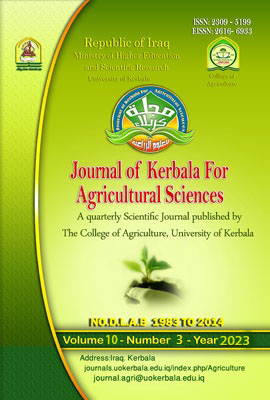Survey the Crystal Type and Physiochemical properties of Isolated Starch Form Some Iraqi and Imported Genotypes of Corn (Zea Mays) Cultivated in Sulaimani-Iraq
DOI:
https://doi.org/10.59658/jkas.v10i3.1243Keywords:
cornstarch, amylose, amylopectin, granule size, Gel consistency, X-Ray diffractionAbstract
The objective of this study is to conduct a survey comparing ten different genotypes of corn. (zea mays L.) cultivated in Qlyassan research station of College of Agricultural Engineering Science, were to find out the type of crystalline form of starch extracted from studied corn genotypes. There were significant differences between the studied corn genotypes in the chemical composition, especially amylose and amylopectin, in which the amylose range was between 19.935 and 31.095 there were also differences in the mean sizes of the starch granules which was 12.795 to 15.915 m, as well as for Gel consistency, despite of significant differences between corn genotypes starch, all genotypes undergo to soft gel consistency, but all of these were not have affects the type of amyloid crystal, which was type A.
Downloads
Published
How to Cite
Issue
Section
License
Copyright (c) 2023 Copyright (c) 2024 is the Author's article. Published by the Journal of Kerbala for Agricultural Sciences under a CC BY 4.0 license

This work is licensed under a Creative Commons Attribution 4.0 International License.
Licensing Terms
All articles are published under a Creative Commons License and will be directed to the Creative Commons Attribution 4.0 International License (CC BY 4.0) That permits use, distribution, and reproduction in any medium, provided the original work is properly cited. This license also allows the work to be used for commercial purposes.
Use by both non-commercial and commercial users
This content is licensed under a Creative Commons Attribution 4.0 International (CC BY 4.0) license, permitting use by both non-commercial and commercial users. Individual users may access, download, copy, display, and redistribute the articles to colleagues, as well as adapt, translate, and text- and data-mine the content, subject to the following conditions:
- The author's moral rights, including the right of attribution and the right to protect their work from derogatory treatment, are respected.
- Where content in the article is identified as belonging to a third party, users must ensure that any reuse complies with the copyright policies of the owner of that content.
- If the article content is reused for research or educational purposes, users should maintain a link to the appropriate bibliographic citation, including the DOI and a link to the published version on the journal's website.






